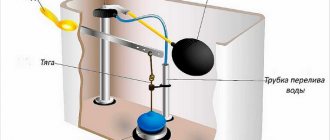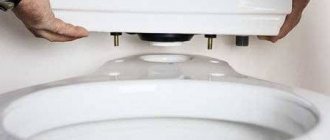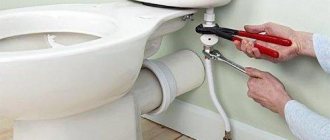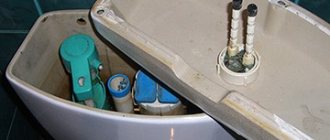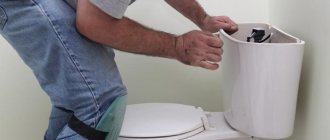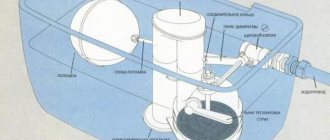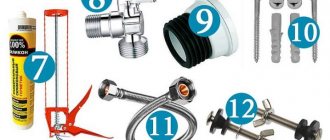There are circumstances when water does not fill the toilet cistern or flows into it too slowly and poorly. In this case, you should first find the source of the malfunction (perhaps the factor is not serious), and then eliminate the problem as soon as possible. Moreover, sometimes such an incident can occur due to an absolutely nonsense situation.
How and what the master will repair
We are all inquisitive people, so in addition to the question that is quite common among customers of the service - why water does not fill the drain tank, we want to find out what exactly the master will do. We have no secrets. We do not hide our actions and will be happy to share information. The skill lies in the long-term work of our specialists, more than 10 years, in their experience and skills, and not in secret actions.
If water does not flow into the toilet tank due to skew or incorrect installation of the float, we will fix it and show you how to do it yourself in the future.
If there are cracks in the supply hose, when water takes a long time to fill the toilet tank, the hose needs to be replaced. Leaks may be so minor that they will have to be determined using simple tests.
If there is a suspicion that water does not flow into the toilet tank due to a clogged valve, then the technician, after making sure of this, will eliminate this problem. He will turn off the water supply, remove the supply hose and check the connection between the hose and the plumbing fixture.
If water takes a long time to fill the toilet tank due to a blockage, you may have to disassemble the device. This is business as usual for our specialists.
Very often, the toilet tank does not fill well with water due to deposits of rust and salts. In this case, it is possible to use special chemicals to dissolve deposits and clean the drain system.
Another reason why water does not flow into the toilet tank is that all parts are installed and screwed with great effort. The fasteners are simply “twisted” and do not function as expected. In such cases, it is enough to loosen the assembly in some places for the tank to start working again.
There may be many trivial reasons that affect the fact that your toilet tank does not fill water well, but all of them can be easily identified by our specialists and eliminated in the shortest possible time.
If the toilet does not fill the tank with water, then the best thing you can do yourself is to dial our phone number. Your problems are our job, which we do better than others.
By calling us by phone, you will solve several problems at once:
- your toilet will work normally;
- you will receive some practical advice on its further operation;
- you will find a company that will constantly solve all your plumbing problems;
- Thanks to us, your plumbing will always work.
Just call and solve your problems quickly and permanently.
Main reasons
The question of the occurrence of malfunctions cannot be answered unambiguously. There are many reasons why water slowly fills into the toilet tank. Therefore, it is worth checking the entire mechanism sequentially, starting from the very beginning:
- The first step is to check the presence of water supply to the tank, because the fault may not be in the mechanism of the device.
- In a situation where the supply pressure is less than in other taps of the system, it is worth checking the supply pipe for leaks or blockages.
- It happens that a blockage occurs in the tank hose tube when it is connected to the system.
- The next thing to check is the float mechanism of the device, due to its incorrect position, water can also slowly flow into the toilet tank.
- Then it’s worth checking how freely all the elements of the drain mechanism work, because too tight an assembly can also slow down the flow of water.
- During long-term operation, the inlet valve may develop its own wear, which will also affect the operation of the device.
- In addition, during prolonged use, rust may deposit on the walls of the tank, as well as the elements of the mechanism, or limescale may form. These reasons will interfere with the smooth operation of the moving components, leading to a slowdown in the water supply process.
If you cannot independently determine the reason why water is slowly filling into the toilet flush tank or eliminate it, you need to call a plumber to your home.
General characteristics
The functioning of the flush tank is based on the good old law of gravity, thanks to which a predetermined amount of water collected in the tank, after pressing a button, descends at high speed to the riser and then goes into the sewer. Experts call the insides of the tank shut-off valves. It is she who takes on the function of controlling water flows, in other words, filling the tank and draining the liquid.
A float is needed to control the level of collected water. When the drain button is pressed, the water drops and the float falls with it, after which the valve opens. Float valves differ in their location: they are side and bottom. The device also has a whole drain and overflow system. It consists of a flexible and rigid connection, a steel pipe, a cast iron angle, a winding and a lock nut. When the tank is overfilled, its tightness is ensured thanks to a rubber gasket, and a special washer presses it to the body
Don’t forget about such an important detail as the filling valve - it regulates the amount of water and supplies it as needed.
Simple toilet design
In the end, it all works this way: when a sufficient water level is reached, the float floats up, lifting the rocker arm with it. It, in turn, turns, pressing the valve with the gasket, and blocks the access of water. In order to adjust the maximum fluid level, the rocker arm simply bends.
The trigger mechanism is a button on the toilet lid or a chain on the side of the body. The button is more common, since installing the tank on the toilet shelf is the simplest and most compact option. It is convenient because, if necessary, you can reach the internal structure by simply lifting the lid. If the tank is mounted on a wall closer to the ceiling, it is equipped with a lever with a chain. Such a tank is connected to the toilet with long fittings, and this design provides the most powerful water pressure. However, hanging tanks are rapidly losing popularity due to their not very pleasant appearance. There is a third, most modern option - a drain button mounted into the wall. This solution looks very aesthetically pleasing and helps save space, since it involves a cistern, also built into the wall. The downside is the complicated installation of the product and the inability to quickly access the filling of the tank if you suddenly need to fix any problem.
Now that we know the main characteristics, as well as the types of designs of the drain tank, we can consider the reasons why water does not flow well into the tank.
Debris in the intake valve
If the cause of the malfunction is clogging, you must first turn off the water supply and disconnect the supply hose from the water supply system and then check it. If the cause remains unfound, then the next valve on the way will be the valve that shuts off the fluid supply to the tank. Sometimes this element also becomes clogged with debris, which causes limited water flow.
To eliminate this problem, the flexible hose is connected back, and the drain valve is cleaned with a wire, slightly opening the water supply so that it can carry out all the separated deposits. If the cause is determined correctly, this procedure will help to ensure proper operation of the valve. However, after the valve has been cleaned, the water supply should be closed several times and the water supply restored. This precaution will ensure that all loose debris comes out of the valve.
At the final stage, the valve is assembled back together with the water supply valve to the tank closed. Afterwards, the liquid supply is resumed, and the level of its accumulation in the tank is regulated using the existing limiters. Such a breakdown can often be detected if water slowly fills into the cistern of a toilet with a side connection.
Replacement
In order to change fittings, you need to select them correctly
Pay attention to the differences between your old mechanism and the new one, for example, the connection may be bottom or side. Consult with a consultant which design is more suitable in your particular case
Once the necessary parts have been purchased, installation can begin:
- First, turn off the water supply to the toilet tank.
- We remove the buttons: to do this, you need to carefully unscrew them.
- Remove the tank cover.
- Disconnect the liner
- Then you need to remove the drain column. It is advisable to do this in parts: first, the first part is dismantled by turning it 90 degrees, then the second.
- Then unscrew the tank fasteners.
- We disconnect the tank and place it in a place convenient for further work.
- At the next stage, you need to unscrew two nuts: the valve fastenings and the column fastenings. Then we take out the second, remaining part of the reinforcement.
- We install the new mechanism and do the reverse work, installing the tank in place.
It happens that even after all these steps the tank still does not work properly. Here the design definitely needs to be checked by a professional who will make an accurate diagnosis and determine the price of repair. Sometimes the reason may be a trivial renovation in a neighboring apartment - in this case, the problem with the water supply may not only be yours.
We can conclude that problems in the operation of the insides of the tank are not a tragedy at all, but simply an issue that requires a competent solution. Nevertheless, in cases of serious breakdowns, it is better not to get carried away with unnecessary amateur activities, but to immediately contact a specialist.
Water does not flow into the toilet cistern. How to fix a toilet? Replacing the inlet valve.
Modern plumbing allows its owners to carry out repairs on their own. Most often, malfunctions occur in the toilet cistern. Despite the existence today of many different designs of cisterns, the principle of their operation is the same. All tanks consist of two working units: a water inlet mechanism and a water release mechanism into the toilet. The water release button or handle is located on the tank lid and is activated when pressed or lifted.
Water from the general water supply system flows through a flexible hose into the drain tank. When the tank is filled with water to a certain level, the float will rise and close the membrane, and the water will stop flowing. When you press the button or handle of the trigger mechanism, the bulb rises and water from the tank flows into the toilet.
Most often, malfunctions occur in the operation of these mechanisms of the drain tank. The most common malfunctions that every owner complains about are why water does not fill into the toilet tank and why water constantly runs out of the tank. Many people immediately begin to get upset and think about replacing the toilet. There is no need to rush into such radical measures. As a rule, all you need to do is replace a hose or some part, adjust the water supply or change the drain valve.
The first thing to check is the position of the float or valve. The float may be a little skewed
Then you need to carefully move them and return them to their previous position. To do this, simply remove the lid of the toilet barrel and move the float
In most cases, this simple procedure will be sufficient. However, if this does not help you, then you will have to carry out minor repair work.
Disconnect the water supply system to the tank: use an adjustable wrench to unscrew the hose that connects the tank and the water supply pipe and check whether water is supplied through this hose.
Clear the blockage: water flows, but why doesn’t the tank fill? This means the problem is clogging. In this case, you need to use a nail or other sharp object to clean the junction of the pipe with the tank.
Reconnect the flexible water supply hose and check that the drain tank is full. If water still does not flow in and this does not help, then only replacing it with a new similar water inlet mechanism will help.
Operating principle and design of the drain system
Many property owners, in the event of the slightest malfunction of the plumbing plan, call a specialist; perhaps this is a justified approach, but, having the initial skills of a repairman and a set of simple tools, the vast majority of breakdowns can be eliminated on their own. Of course, in order to get the desired result before starting to repair the tank, you need to understand its structure, since there is nothing complicated inside the massive body.
There are several types of tanks; their appearance may differ significantly, but the internal structure is almost identical. Their work is based on the same principles; they consist of parts similar in purpose.
The main components of a flush cistern:
- housing with removable cover,
- float with rod system,
- valve that regulates the flow of water into the tank,
- bulb, or drain valve,
- Overflow protection system that prevents the tank from overfilling.
After a person activates the flush system by pressing a button or turning a lever, the bulb rises, allowing water to flow into the toilet bowl. As the liquid level decreases, the float lowers. The water drains completely or to a predetermined level, the draft transmits force from the float, the valve opens, and the tank begins to fill with water.
During filling, the float rises and at a certain moment stops the water supply. Then the system remains idle, waiting for a new press to drain, after which everything repeats. This is how the tank should work, but sometimes breakdowns occur that have to be corrected, often in an emergency.
What to do if water does not flow into the toilet tank
If you decide to figure out the reasons why water does not get inside the tank and fix the problem yourself, you will need to work a little. There is absolutely no guarantee that you will succeed, but trying is not torture. After all, your image as a man is at stake, and there is an opportunity to hold back your finances a little. Of course, it is impossible to describe all the malfunctions, but we will try to consider the most common ones.
Eliminating float misalignment
If water does not fill the tank at all, then you should not blame the float. If it flows a little, but does not reach the required minimum, then inspect the float and check that it is positioned correctly.
After the tank lid is removed, the entire inside will be revealed to your eyes, as well as the mechanism and lever, at the end of which the float is attached. It is this that activates the inlet valve, closing it when the water level reaches the required level.
If the float arm is misaligned, it may shut off the water flow prematurely. It is necessary to set it to its normal position by slightly twisting and bending the lever. This should restore system functionality.
Cleaning the supply valve
If there is water in the tap, but does not reach the drain tank, it is likely that the inlet valve is clogged. Dirt, sand, plaque or mucus may accumulate in it. It is better to carry out preventive work in a timely manner and such problems will not arise:
- Shut off the water supply to the tank.
- Disconnect the water supply hose from the tank and pull it out. Work carefully but persistently. Water sediment often makes unscrewing very difficult.
- Inspect the valve for any blockage. Use steel wire to remove it.
- Open the water tap slightly - this will allow the water pressure to remove any remaining dirt.
After solving the problem, all that remains is to put the system back together. The fastening should be tight, but not overtightened. Check the water intake level, if necessary - make adjustments by bending the lever and adjusting the float.
Faulty water supply hose
When solving the problem of lack of water in the tank, do not forget to inspect the supply hose. Its damage is in second place among all probable causes:
- Shut off the water supply in the apartment or on the riser.
- Disconnect the supply hose. Examine it. If holes or cracks are noticeable, the hose must be replaced - there are no options.
- If no damage is noticeable, then place the hose in a bucket and open the valve slightly.
- Now the water itself will show the location of the fault, if any.
- Replace the hose. And calmly continue to use the toilet.
Clearing a clogged tank drain
If there is a blockage in the tank drain, this can also cause problems, although it will not affect the filling of the tank. Water will flow into it regularly, but it will not be able to drain:
- You need to unscrew the drain button and remove the cover.
- inspect the valve responsible for water discharge;
- If debris is visible on it, you should clean it with your hands.
If there is no debris, then the reason probably lies in the pipe connecting the toilet to the tank. Plaque and mucus may accumulate on the walls of the tank. All this must be cleaned in a timely manner.
Prevention is best done using chemicals. However, when working, do not forget about protecting your hands and respiratory tract.
Drain block
If you have such suspicions, you first need to remove the float and also inspect the bottom of the drain tank. Sediment may accumulate here, which must be carefully removed by hand. Then you need to inspect the drain surface inside the tank. During the process of removing sediment, it may become clogged with debris of various fractions. To make cleaning the drain easier, you can use tweezers of the appropriate size.
Related article: Wall hung bidet toilet
Sometimes it may not be possible to clean the surface of the drain from above. To do this, you need to disconnect the tank from the bowl and try to clean the drain from below. The walls of the tank should be cleaned of deposits using detergent, which is purchased on the recommendation of the seller from the household chemicals department. When the problem is resolved, the tank is reassembled into its original position and checked. If, as a result, water continues to slowly fill into the toilet tank, it means that not all reasons have been identified and it is worth checking the remaining elements.
Types of breakdowns
So, the drain has stopped working and you have a reasonable question: “why isn’t water flowing into the tank?” Without yet knowing the source of the problem, it is better to stock up on universal tools just in case: an adjustable wrench and any sharp object (a nail will do).
Toilet cistern design
Here are the main reasons why water does not fill the toilet tank:
- No water supply. Yes, no matter how trivial it may be, first of all, just in case, you should check the presence of water in the whole house, perhaps the tap is turned off and the tank mechanism has nothing to do with it.
- Float misalignment. The simplest action is to check the correct position of the float or valve. Here you just need to adjust the float a little so that it falls into place. If this does not help, then the problem is not with the float valve.
- Clogged pipe. A blockage occurs when the pipeline is changed and the water is temporarily turned off - then its composition noticeably changes and the presence of rust can be noticed with the naked eye. In order to check whether the connection to the tank is clogged, you first need to turn off the water supply to the tank, and then release the hose connecting the tank and the water supply system. The next step is to check the water flow through this hose. If it is missing, the reason is a blockage and you need to carefully clean the connection using a long, sharp object. Then we connect the hose back and check whether water is collected.
- Rust in the filter. Sometimes the water stops flowing because scale gets under the hose nut and over time the pressure weakens, and then the tank stops filling up altogether. In this case, you need to remove, rinse and clean the filter, if any.
- Float is dirty. When the inlet valve belongs to the “economy” category, the float rising along the guide over time becomes overgrown with mucus, plaque and ceases to perform its main function. Here you should remove the float mechanism and thoroughly clean all rubbing surfaces.
- Exhaust valve wear. If your tank has been installed for a long time, the float mechanism could simply wear out. In this case, you will need to replace the exhaust valve, but you can do it yourself - it’s up to you to decide.
- Leak. Sometimes water simply does not have time to fill the tank, because it immediately flows into the toilet itself, without being retained in the tank. For the same reason, unsightly rusty stains form on the inside of the bowl, and the displacement is consumed at a rapid pace, which entails additional costs. In this case, it will be necessary to replace the siphon membrane, which, when worn, loses its ability to seal the hole hermetically. You need to rinse the water from the tank, remove the siphon, replace the membrane with a working one and secure the siphon in its original place by screwing in the fasteners.
- Setting up the intake tract. Sometimes, if the system is assembled too tightly, water is collected extremely slowly. Then you will have to weaken a certain element, which one only a plumber can tell, so that the pressure returns to normal.
If you are not sure of the performance of any individual parts of the mechanism, it is better not to try to repair them, but to replace them with new ones as soon as possible, especially since the shut-off valves cost mere pennies. In the event that partial repairs do not bring the desired result, you need to undertake a more global repair, namely, a complete replacement of the entire drain mechanism. It’s not at all difficult to do this yourself, provided that you have before your eyes a detailed diagram of the tank’s structure, detailed instructions, and preferably also an understandable video tutorial.
Replacing broken parts is quite easy
What causes the malfunction?
If the toilet tank does not fill with water or the liquid flows there slowly, the reasons may be:
- Lack (shutdown) of central water supply.
- Malfunction (leakage) of supply water pipes.
- The hose connected to the tank is clogged. In most cases, such a malfunction occurs after repair work has been carried out on the water line.
- The presence of a large amount of debris in the filter.
- Plaque and mucus. Accumulates after prolonged use of a plumbing fixture.
- Worn toilet inlet valve.
- Incorrectly assembled drainage system.
Why doesn't water flow into the toilet cistern?
There are situations when plumbing equipment fails; this phenomenon is quite standard and natural. Anyone could handle old models of devices, but modern devices are so technologically advanced that it is often difficult for an inexperienced person to find a breakdown and fix it on their own.
If the drain tank is dry, you need to give this problem time and attention, otherwise it may lead to more serious problems. But you shouldn’t overpay extra money to call a specialist.
You can try to figure it out on your own. So what could be the reasons that the tank has stopped filling?
If the system is working properly and the pressure is good, then you need to start looking for a problem elsewhere. Sometimes toilets are equipped with separate risers. Check in the basement to see if the cap is blocked. Sometimes even a conversation with neighbors is enough to figure out the reason. It could be:
- Incorrect placement of the float - inspect it first;
- blockage or damage in the supply pipe - sometimes this may well cause a weak flow or its complete absence;
- the presence of rust or sand at the place where the pipe is connected to the tank - this is especially typical if the water supply system has recently been repaired;
- the inlet valve is damaged or clogged, which, naturally, will prevent the tank from filling.
In addition, the cause of such a malfunction can be over-tightened fasteners. Double-check everything carefully, twist the connections. Everything should fit snugly, but not be overtightened. Is there mucus and plaque on the walls inside the toilet? This may also be one of the reasons for the malfunction.
Checking the supply hose
After removing suspicions from the plumbing system supplying water to the toilet tank, you should check the supply hose itself. It is disconnected from the connection pipe of the device and directed into a prepared container, which can be used as a bucket. If the fluid pressure at the hose outlet matches the pressure in the water supply system, then a malfunction in the hose can be ruled out. This means that the reason why water is being drawn into the toilet tank very slowly should be looked for elsewhere.
Consequences of malfunctions in the drain mechanism
If water slowly fills into the toilet tank, what should you do? This is a fairly pressing question that can be easily answered by practicing plumbing specialists. However, it is worth remembering that malfunctions in the operation of the toilet cistern mechanism can not only cause inconvenience to the apartment owner, but also cause trouble for the neighbors below.
The formation of deposits inside can cause the float to block in the starting position, resulting in a risk of overflow. Thus, if this incident goes unnoticed, then water will not only end up on the floor, but can also penetrate to the neighbors.
An unrepaired inlet valve will eventually stop allowing water to pass through completely. This may result in the need to replace all of the cistern's internal hardware.
Step-by-step instruction
First, it is necessary to eliminate the incorrect position of the valve or float. These parts may move slightly. If there is a misalignment, you should remove the lid from the toilet tank and carefully adjust these elements by hand, putting them in place. Often, performing these simple steps is enough to fix the problem.
If this does not help, minor repairs will be required.
How to correct the situation if water does not enter the system
Before repairing the tank, turn off the tap water in the system. Then perform the following steps:
- Using an adjustable wrench , unscrew the hose connecting the water supply tube to the tank and check the free flow of liquid.
- Remove existing blockage . This must be done when water passes through the hose but does not fill the tank. Contamination may be in the pipe or its junction with the drain system. This area is cleaned with a nail or any other long sharp object.
- After this, the flexible hose is attached back to the tank and checked whether the container is filled with water.
Float repair
Malfunctions of this part, as a rule, are of two types: the float does not supply water to the system at all or does not completely block its flow. Problems are usually caused by either the float itself or the valve. Float designs may vary. They produce models of plumbing fixtures in which this part is hollow inside. There are also floats that resemble a cup turned upside down. The first option much more often stops functioning normally, since water can get into it. In this case, the situation can only be corrected by completely replacing the locking mechanism. The second version of the float is somewhat more convenient to use, however, over time, dirt accumulates on it and it can also fail. The problem is easy to fix - just rinse this system component well.
The shut-off fittings or valve, which restricts the water supply, ceases to cope with its functions due to contamination of the membrane or holes that allow water to pass through. To repair these parts, the float is disassembled. To remove the membrane, you need to remove the protective cap by turning it slightly . All membrane ducts are thoroughly washed, and then the part is put in place and the cap is screwed back on. However, it is often advisable to replace the membrane. Typically this spare design element is included when purchasing a new float.
Float adjustment
To adjust the position of the float, you need to perform a number of simple manipulations. You need to fill the drain tank and monitor the level to which the water reaches. The liquid should be located three to four centimeters below the side openings of the tank. Some drainage systems do not provide such clearances. Then pay attention to the body of the drain device - the liquid should lightly cover it.
You can get the required water level in the tank by raising or lowering the float. By raising this element of the system, you can increase the mass of water collected, and by lowering it, you will reduce the amount of liquid. Adjustment is carried out using a special screw or rail (the second option is often found in inexpensive plumbing models).
Fixing drainage problems
The troubles that arise due to a breakdown of the flush mechanism mainly boil down to the continuous flow of water into the toilet bowl. There are several reasons for such problems:
- Incorrectly adjusted overflow . Sometimes the tube drops lower than required and the float collects too much water. The overflow tube is manually adjusted by simply lifting it. Sometimes it is enough to slightly tighten this part and the leak is eliminated. In some cases, additional adjustment of the position of the overflow elements may be required.
- Faulty valve . Sometimes the rubber valve stops holding water. It may become clogged or dry out.
In order to solve this problem, the mechanism is disassembled. In this case, the drain tank does not need to be removed. The drainage device can be easily separated into two halves, thus giving you access to the drainage hole and the valve itself. These parts need to be cleaned, then the mechanism must be reassembled and its functioning checked. Sometimes to eliminate such a malfunction it is necessary to replace the membrane.
A leak can also occur at the junction of the tank and the toilet. Such problems can be eliminated by replacing all gaskets and rubber seals for fasteners or screws. To do this, the tank reservoir must be removed.
If a breakdown occurs in the parts of the locking mechanism, then it is necessary to replace all failed elements or buy new shut-off valves.
As you can see, the cistern design of different toilet models is the same and has a fairly simple operating principle. If you understand the mechanism of action of all parts of the drain system, carrying out routine repairs will not be difficult. You can easily troubleshoot problems yourself. It is only important to notice the breakdown in time and solve the problem of a faulty tank.
Tank repair technology
Water enters the drainage system from a water pipe, passing through a flexible hose. After the tank is completely filled, the rising float closes the membrane and blocks further access to liquid. When you press a button or release a lever, the rubber bulb moves up and water pours out, washing the bowl.
It is these parts that usually fail, and then water does not flow into the toilet tank or the device constantly leaks. In this case, it is not at all necessary to immediately prepare to replace the plumbing product. Often it is enough to simply buy a new hose or other structural element.
In some situations, you can get by with regular water supply adjustments or replace the drain system.
In order to repair a faulty drain tank, you need to prepare the following tools:
- a sharp and long rod or nail;
- adjustable wrench.
Malfunctions and causes of their occurrence
If water has stopped flowing into the toilet tank, then you need to pay special attention to such a malfunction and try to fix the breakdown as quickly as possible, otherwise the toilet may completely fail, in which case you will need to replace the entire structure. In order not to spend extra money on the services of a plumber and not to buy new equipment, you can try to cope with the breakdown yourself. However, first you need to find out exactly why it happened.
You shouldn’t immediately rush and disassemble the device; first, make sure that there is water in the plumbing system of your apartment or house. According to experts, about 40% of all malfunctions with water drainage occur due to the fact that water does not enter the structure itself.
That is why you first need to clarify whether there is a cold water supply in the house, and only after that move on to searching for the reasons that led to the malfunction.
If the system is completely filled and there is a sufficient volume of water in it, but the device is not working, this may indicate another type of breakdown. These include the following types of faults.
- The float is in the wrong position . This nuisance often causes the toilet tank to not fill. Also, a breakdown can cause leakage, which further aggravates the situation. Such a malfunction must be eliminated first of all, since the float tends to let or completely block liquid when in different positions.
- The water supply hose supplying water is damaged or clogged . Such breakdowns cause too slow flow of fluid from the system, and sometimes completely block it. Cases often arise when rust particles or sand collect in the place where the toilet pipe connects to the plumbing fixture or in its filter. This circumstance also often becomes the explanation for the fact that liquid takes too long to fill the reservoir or does not flow at all. Most often, such blockages occur after repairs to utility lines.
- The exhaust valve is broken, clogged, or otherwise damaged . This happens when fasteners - nuts, bolts and other structural parts - are too tightly tightened. You should inspect all connections as carefully as possible, make sure that everything is assembled securely, but at the same time not overtightened.

